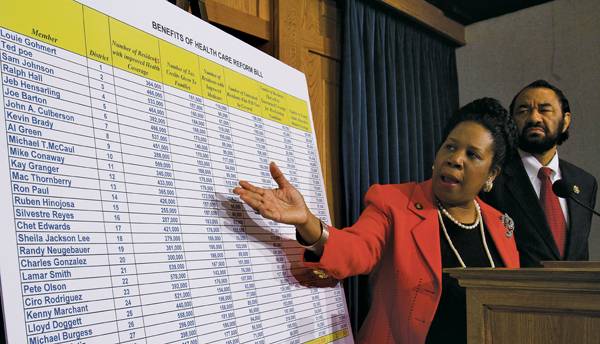HASENMILLER: Don’t look too far ahead

Rep. Sheila Jackson Lee, D-Texas, left, accompanied by Rep. Al Green, D-Texas, gestures during a news conference on Capitol Hill in Washington on Thursday, to discuss the Attorneys General lawsuits on the health care bill. Photo: Harry Hamburg/The Associated Press
March 27, 2010
The health care bill that was passed by the House of Representatives last Sunday is predicted to decrease the federal deficit over the next 10 years. You may be wondering how we can save money by passing a bill that costs nearly a trillion dollars, but the answer is simple.
The bill increases taxes for the whole decade, but doesn’t start paying out benefits for another four years. So 10 years of taxes can pay for six years of health care. As long as you don’t look past 10 years from now, it appears to be a good deal. Well, OK, still maybe not a good deal, but a better one than what it actually is anyway.
Of course, that’s only the case if the bill’s costs are what have been predicted — which they will almost definitely not be. As is the case with many government programs, it will likely cost much more than expected. Here’s why:
1. The law of demand. This law states that as something becomes cheaper, people will buy more of it. In the case of health care, once somebody else — the taxpayer — is paying for it, people will purchase more, thus leading to a higher cost.
2. Moral hazard. This is the idea that when you insure a risk, people are more likely to engage in risky behavior due to the reduced consequences of their actions. In the case of health care, once everyone has insurance the cost of being unhealthy will decrease, so people will be more inclined to engage in unhealthy behaviors.
3. Pre-existing conditions. Insurance companies pool together the money of individuals whose levels of risk are hard to predict, so that overall, the total amount of risk is easy to predict.
The money is then given back to those individuals who, in the case of health care, get sick. Forcing insurance companies to insure those with pre-existing conditions is not risk-pooling. It’s simply a way of forcing others to pay for that condition.
4. The law of supply. This law states that as you produce more of something, the cost per unit increases. This means that if we increase the amount of health care consumed by X percent — both by insuring more people overall and because of the above effects — the total cost of that health care will increase by more than X percent of its current costs.
Because of these effects, you should expect the total cost of this bill — which is already predicted to be more than the revenue generated by the tax increases that went with it — to keep increasing beyond predicted levels. These additional costs may be made up by further increased taxes, an increased national debt, inflation, cuts to other areas of government spending, decreased health care quality, rationing of health care, or some combination thereof.
But regardless, we’ll all have to pay somehow.
Blake Hasenmiller is a senior in industrial engineering and economics from DeWitt.






